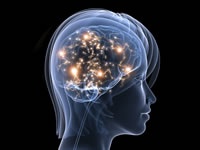Providing tools for clinical assessment and developing devices for rehabilitation are central to the impact of our research. Led by Prof. Crawford, many quantitative methods for clinical assessment have been developed, which are widely used in clinical practice. In addition, innovative research on the human visual system, led by Prof. Sahraie, has provided direct benefits for the visually impaired.
- Rehabilitation of sight loss after brain injury
-
Physiotherapy for the eyes – development and commercialisation of new therapy for rehabilitation of sight loss after brain injury

A research program led by Professor Sahraie developed a new technique for aiding the recovery of vision in stroke patients called the Vision Rehabilitation Program ™. The technique involves a computer-based daily training programme, presenting specific visual patterns within the damaged visual field of a patient. Such systematic and repeated stimulations can lead to increased visual sensitivity.
150 stroke patients used the therapy via a University of Aberdeen spin out company, Sight Science Limited, now a subsidiary of a US company NovaVision Inc. Many of these patients reported that the new therapy led to a better quality of life.
The brain may be able to be trained to use surviving functioning nerves within the damaged areas. Our therapy is designed to encourage the use of remaining nerve pathways to compensate for the damaged areas. Patients experience an improvement in their visual sensitivity
Professor Arash SahraieFind out more
Key publications
- Sahraie, A., Trevethan, C. T., Weiskrantz, L., Olson, J., MacLeod, M. J., Murray, A. D., Dijkhuizen, R. S., Counsell, C. E. & Coleman, R. (2003). Spatial channels of visual processing in cortical blindness. European Journal of Neuroscience, 18, 1189-1196.
- Sahraie, A., Trevethan, C. T., MacLeod, M. J., Murray, A. D., Olson, J. A. & Weiskrantz, L. (2006). Increased sensitivity after repeated stimulation of residual spatial channels in blindsight. Proceedings of the National Academy of Sciences of the USA, 103, 14971-14976.
- Sahraie, A. (2010). Improved detection following Neuro-Eye Therapy in patients with post-geniculate brain damage. Experimental Brain Research, 206, 25-34.
- Statistical Methods for Clinical Assessment
-
Harnessing computer capability to help clinical practitioners to use a range of psychological testing to assist with neuropsychological testing

Professor John Crawford, Professor of Psychology at the University of Aberdeen developed a range of methods to allow medical practitioners to gauge and compare the performance of an individual patient - for example, mood scores to determine anxiety or depression, which are compared against a reference sample drawn from the general adult population.
In order to make this information more accessible to non-neuropsychological specialists, he created a large suite of tailored computer programmes for use in clinical research and practice. By making this information accessible, medical practitioners are able to use psychological testing and interpret results with increased confidence. These methods have been very widely adopted and used in over 10,000 clinical publications (see Professor Crawford's Google Scholar page).
Our computer programmes are freely available and are designed to be user-friendly for practitioners. There has been an explosion in the amount of published data available to clinicians. Our regression- based methods and programs allow such data to be applied to form inferences concerning an individual patient
Professor John CrawfordFind out more
Key publications
- Crawford, JR, Henry, JD, Crombie, C, and Taylor, EP. (2001). Normative data for the HADS from a large non-clinical sample. British Journal of Clinical Psychology, 40, 429–434.
- Crawford, J. R., & Henry, J. D. (2003). The Depression Anxiety Stress Scales: Normative data and latent structure in a large non-clinical sample. British Journal of Clinical Psychology, 42, 111-131.
- Crawford, JR, & Garthwaite, PH. (2007). Comparing patients' predicted test scores from a regression equation with their obtained scores: a significance test and point estimate of abnormality with accompanying confidence limits. Neuropsychology, 20, 259-271.
- Crawford, JR, & Howell, DC. (1998). Comparing an individual’s test score against norms derived from small samples. The Clinical Neuropsychologist, 12, 482-486.
- Crawford, J. R., & Garthwaite, P. H. (2005). Testing for suspected impairments and dissociations in single-case studies in neuropsychology: Evaluation of alternatives using Monte Carlo simulations and revised tests for dissociations. Neuropsychology, 19, 318-331.
- Crawford, JR, Garthwaite, PH, & Gault, CB. (2007). Estimating the percentage of the population with abnormally low scores (or abnormally large score differences) on standardized neuropsychological test batteries: A generic method with applications. Neuropsychology, 21, 419-430
